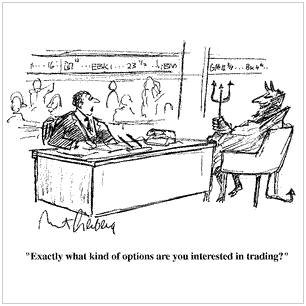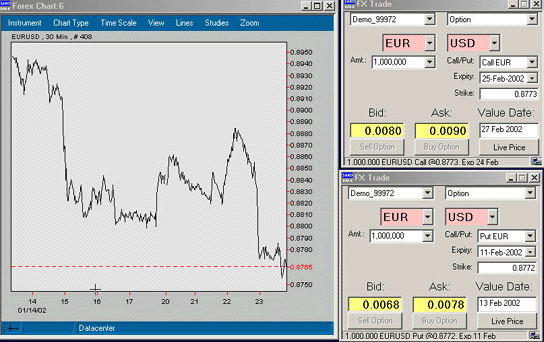Most stock and futures traders are at least familiar with basic option-trading concepts, but options are a much different beast in the forex world.

As forex trading continues to expand in the retail trading space, one aspect of the market many traders have wondered about is option trading.
Although they are not yet a common part of retail spot forex trading, individual market players do have access to option trading – depending on their broker. Options in the spot forex market are not standardized the way options contracts are for exchange-traded stocks and futures – that is, there are no predefined strike prices or expiration dates all brokers and traders use. If your brokerage offers option trading, they likely have their own relatively set menu of option contracts, as well as the ability to create a customized instrument of your choosing.
Forex Option Characteristics
Unlike option trading in the equity and futures markets where options expire at regular intervals (e.g., every 30 days or three months) and can be traded online, in the forex world customers typically must trade options over the phone – but they can also create customized option contracts with just about any strick price and expiration.
This customization gives traders flexibility, but it also makes FX options more complicated because of the difficulty of determining if a particular option is fairly priced. Most forex firms, including Gain Capital and HotSpotFX, say they are not yet seeing much interest from customers. As a result, forex option trading is best suited for experienced traders according to Gain, which offers FX option trading within its traditional FX platform.
Most platforms do not charge commissions for options; they are compensated through the bid/ask spread. Forex options are typically constructed to expire in one or two weeks, but again, that is up to the brokerage and the customer.
Option Types and Strategies
Forex options come in two flavours: vanilla and exotic. Vanilla options are simple calls and puts familiar to stock and futures options traders. Exotic options refer to either combinations of options (spreads) or variations on the payoff profiles of vanilla options – completely different kinds of products with option-like characteristics.
One type of forex option trade that falls into the last category is a “fixed-rate” option, which is a unique transaction that enables a trader to profit by a predetermined “payout” amount if the trader’s selected price or price range is reached during a specific trading period.
Generally a brokerage will divide each 24-hour trading day into multiple trading sessions. Prior to the start of a trading session, the firm will typically indicate price limits for certain currency pairs within which fixed-rate options orders may be entered for that trading session. The firm will then quote the premium the trader must pay to buy the fixed-rate option trade. Once an order is entered, the premium for the trade is automatically deducted from your trading account.
If the selected price or price range of the underlying currency pair is reached during the trading session, a pre-set pay-out (which the firm and customer decide upon as terms of the option “contract”) will automatically be credited to the trader’s account at the end of the trading session. In the event the price of the underlying currency pair is not reached during the trading session, the fixed-rate option will expire, worthless.
For example if the Euro/U.S dollar rate (EUR/USD) was at 1.3028 before a particular trading period, a fixed-rate option contract could be constructed whereby the trader would receive a payout amount of $X if EUR/USD traded above 1.3070 during the trading period.
Barrier options are based on a pre-selected price level (the barrier) in a currency, which if reached will either create a vanilla option (call or put) or eliminate the existence of a vanilla option. These are referred to as “knock-in/knock-out” options.
There are two kinds of know-in options: up and in and down and in. In the case of an up-and-in option, the buyer selects an upper price barrier above the market. If the currency hits that level, a vanilla option position is triggered with a maturity date and strike price agreed upon at the outset.
For example, if EUR/USD is at 1.3028, an up-and-in option might consist of a long call option position with a strike price of 1.3055 being triggered if EUR/USD trades above 1.3050.
A down-and-in option is the same, except the currency must reach a lower barrier to trigger the option position. Upon hitting the chosen lower price level, it creates a call or put option position.
Knock-out options are the reverse of knock-ins. With know-outs, the buyer begins with a vanilla option; however, if the predetermined price barrier is hit, the vanilla option position is cancelled. As with the knock-in option, there are two kinds: up and out and down and out. With an up-and-out strategy, if the option hits the upper barrier, the option is cancelled and you lose your premium. With a down and out, if the option hits the lower price barrier, the option is cancelled.
Risks in trading Spot Forex Options
Forex options contracts are vastly different from options on stocks or futures contracts. There are no standardized contract specifications or centralized, exchange-traded markets, which means there is little or no price transparency; this makes it difficult to determine if the price you pay for an option is close the “fair” theoretical value. Essentially, a forex option is a customized, private transaction between a trader and a brokerage and only traders with significant experience in both forex trading and option-pricing techniques should attempt to make use of option strategies in the forex market.
A put gives its holder the option to sell a particular stock, currency or other underlying at a pre-determined price within a pre-determined period of time. A call gives its holder the right to buy an underlying under the same conditions. Puts and calls can be over the counter (OTC) – meaning investors get to set their own exercise points, maturity and notional size with a counterparty – or exchange-traded, meaning the options can be bought and sold at set expiries, strikes and notionals on an openly traded market. The main components of options pricing are volatility and time to maturity, and more of either will make an option more expensive.
American style: An option that can be exercised at any time until expiration.
At the money (ATM) : An option whose strike price is identical (or very close) to the current underlying stock (or futures) price.
Call option: An option that gives the owner the right, but not the obligation, to buy a stock (or futures contract) at a fixed price.
Deep (e.g. deep in-the-money option or deep out-of-the-money option) : call options with strike prices that are far above the current price of the underlying asset and put options with strike prices that are far below the current price of the underlying asset.
European style: An option that can only be exercised at expiration, not before.
Exercise: To exchange an option for the underlying instrument.
Expiration: The last day on which an option can be exercised and exchanged for the underlying instrument (usually the last trading day or one day after).
In the money (ITM) : A call option with a strike price below the price of the underlying instrument or a put option with a strike price above the underlying instrument’s price.
Intrinsic value: The difference between the strike price of an in-the-money option and the underlying asset price. A call option with a strike price of 22 has 2 points of intrinsic value if the underlying market is trading at 24.
Out of the money (OTM) : A call option with a strike price above the price of the underlying instrument or a put option with a strike price below the underlying instrument’s price.
Premium: The price of an option.
Put option: An option that gives the owner the right, but not the obligation, to sell a stock (or futures contract) at a fixed price.
Strike (“exercise”) price: The price at which the underlying stock is exchanged upon exercise of an option.
Time value: The amount of an option’s value that is a function of the time remaining until expiration. As expiration approaches, time value decreases at an accelerated rate, a phenomenon known as “time decay.”
Volatility: The level of price movement in a market. Historical volatility measures the price fluctuations (usually calculated as the standard deviation of closing prices) over a certain time period – e.g. the past 20 days. Implied volatility is the current market estimate of future volatility as reflected in the level of option premiums. The higher the implied volatility, the higher the option premium.
Spot forex options offer more trading alternatives
The e-forex market keeps getting better for the investor. The rule seems to be that whatever the institutions have to trade, the public will soon have access to it as well. First, spot forex was exclusively for institutional trades and bank customers. Today, everyone can trade spot forex. Now, come options on spot forex. That¹s right, spot forex options.
These will be excellent tools for controlling risk in the e-forex market. Look at the chart below. The euro has come down to support levels and the forex trader with only a spot trading capability will < no matter what the trade< be exposed to huge risks. However, an option place can help considerably. The trader can virtually control the risk and the duration of that risk. With OTC options on spot forex, you could buy a call at any strike price and at a time of duration that you want.
There are downsides, though. A trader needs to understand that options on spot contracts are different in a major respect from options on futures currency contracts. Buying or selling an option on spot is a negotiated deal with the bank. Yes, they use the Black-Sholes formula to determine premium value, but there is no market price. You can buy the option, but it is possible that when you want to sell it there is no buyer. The lack of price transparency is another risk. If you’re trading a forex spot option, the price you paid may be quite distant from its theoretical value, and an informed trader can determine what that price ought to be. Also note whether the option is an American option or European. The European option can be exercised only on a set date.
The chart below shows that a call on the euro at 8773 (at-the-money) costs the ask price of 89 pips. It will expire on Feb. 24. That is an arbitrary date, and a trader can adjust his date, as well. We see the prices on buying a call on the euro at virtually the same strike price for a Feb. 13 expiration. So the trader can overcome being hostage to time and volatility and set his own trading parameters. This is an excellent trading tool.


